Edward Condon
Edward Uhler Condon (March 2, 1902 – March 26, 1974) was a distinguished American nuclear physicist, a pioneer in quantum mechanics, and a participant in the development of radar and nuclear weapons during World War II as part of the Manhattan Project. The Franck–Condon principle and the Slater–Condon rules are co-named after him.[1][2][3]
Edward Condon | |
|---|---|
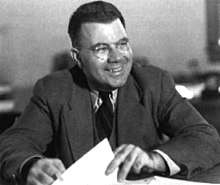 Edward Condon (undated) | |
| 4th Director of National Bureau of Standards (NBS) | |
| In office 1945–1951 | |
| President | Harry S. Truman |
| Preceded by | Lyman James Briggs |
| Succeeded by | Allen V. Astin |
| Personal details | |
| Born | March 2, 1902 Alamogordo, New Mexico, USA |
| Died | March 26, 1974 (aged 72) Boulder, Colorado, USA |
| Citizenship | United States |
| Alma mater | University of California, Berkeley |
| Known for | Radar and nuclear weapons research, target of McCarthyism |
| Scientific career | |
| Fields | Physics |
| Institutions | |
| Thesis | On the theory of intensity distribution in band systems (1927) |
| Doctoral advisor | Raymond Thayer Birge |
| Doctoral students | Edwin McMillan |
He was the director of the National Bureau of Standards (now NIST) from 1945 to 1951. In 1946, Condon was president of the American Physical Society, and in 1953 was president of the American Association for the Advancement of Science.
During the McCarthy period, when efforts were being made to root out communist sympathizers in the United States, Edward Condon was a target of the House Un-American Activities Committee on the grounds that he was a 'follower' of a 'new revolutionary movement', quantum mechanics; Condon defended himself with a famous commitment to physics and science.
Condon became widely known in 1968 as principal author of the Condon Report, an official review funded by the United States Air Force that concluded that unidentified flying objects (UFOs) have prosaic explanations. The lunar crater Condon is named for him.
Background
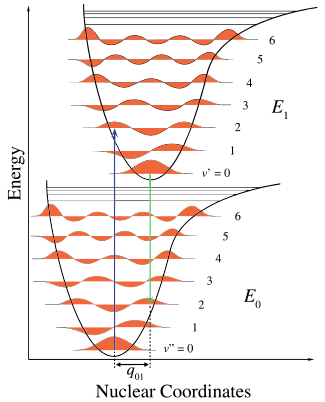
Edward Uhler Condon was born on March 2, 1902, in Alamogordo, New Mexico, to William Edward Condon and Carolyn Uhler. His father was supervising the construction of a narrow-gauge railroad,[4][5] many of which were built in the area by logging companies. After graduating from high school in Oakland, California in 1918, he worked as a journalist for three years at the Oakland Inquirer and other papers.[4]
He then attended the University of California, Berkeley, initially joining the College of Chemistry; when he learned that his high school physics teacher had joined the faculty, he switched majors to take classes in theoretical physics.[6] Condon earned his bachelor's degree in three years and his doctorate in two.[4] His Ph.D. thesis combined work by Raymond Thayer Birge on measuring and analyzing band spectral intensities and a suggestion by James Franck.[7][8]
Thanks to a National Research Council fellowship, Condon studied at Göttingen under Max Born and at Munich under Arnold Sommerfeld. Under the latter, Condon rewrote his Ph.D. thesis using quantum mechanics, creating the Franck–Condon principle.[7] After seeing an ad in Physical Review, Condon worked in public relations at Bell Telephone Laboratories in fall 1927, in particular promoting their discovery of electron diffraction.[4][9]
Career
Early career
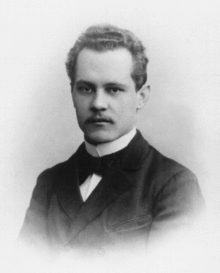
Condon taught briefly at Columbia University and was associate professor of physics at Princeton University from 1928 to 1937,[4] except for a year at the University of Minnesota.[10] With Philip M. Morse, he wrote Quantum Mechanics, the first English-language text on the subject in 1929. With G.H. Shortley, he wrote the Theory of Atomic Spectra, "a bible on the subject from the moment of its 1935 publication".[11][12][13][Note 1]
He was associate director of research at the Westinghouse Electric Company in Pittsburgh, beginning in 1937, where he established research programs in nuclear physics, solid-state physics, and mass spectroscopy. He then headed the company's research on microwave radar development.[10] He also worked on the equipment used to isolate uranium for use in atomic bombs.[4] He served as a consultant to the National Defense Research Committee during World War II and helped organize MIT's Radiation Laboratory.[10][12] On May 11, 1940, Condon showcased his machine called the Nimatron at the 1940 New York World Fair. Condon filed for the patent on April 26, 1940 and got it on September 24, 1940 for his innovating machine, Nimatron.[15]
Government service

In 1943, Condon joined the Manhattan Project. Within six weeks, he resigned as a result of conflicts about security with General Leslie R. Groves, the project's military leader. General Groves had objected when Condon's superior J. Robert Oppenheimer held a discussion with the director of the project's Metallurgical Lab at the University of Chicago.[16][Note 2] In his resignation letter, he explained:
The thing which upsets me the most is the extraordinary close security policy....I do not feel qualified to question the wisdom of this since I am totally unaware of the extent of enemy espionage and sabotage activities. I only want to say that in my case I found that the extreme concern with security was morbidly depressing--especially the discussion about censoring mail and telephone calls.
— Edward Condon[17]
From August 1943 to February 1945, Condon worked as a part-time consultant at Berkeley on the separation of U-235 and U-238.[18] Condon was elected to the National Academy of Sciences in 1944.[13] Following the war, Condon played a leading role in organizing scientists to lobby for civilian control of atomic energy rather than military control under strict security.[19] He worked as science adviser to Senator Brien McMahon, chairman of the Senate Special Committee on Atomic Energy, which wrote the McMahon-Douglas Act, enacted in August 1946, that created the Atomic Energy Commission, placing atomic energy under civilian control.[4][12][19] Adopting an internationalist viewpoint, Condon favored international scientific cooperation and joined the American-Soviet Science Society.[20]
U.S. Commerce Secretary (and former U.S. Vice President) Henry A. Wallace came to know Condon and in October 1945 recommended him as director of the National Bureau of Standards (NBS, now known as NIST). President Harry S. Truman agreed to nominate him. The Senate confirmed his nomination without opposition. Condon served as NBS director until 1951.[21] [4][18] He was also president of the American Physical Society in 1946.[12][13] Condon was also either a member or associated with the Independent Citizens Committee of the Arts, Sciences and Professions (ICCASP).[22]
Attacks
1940s
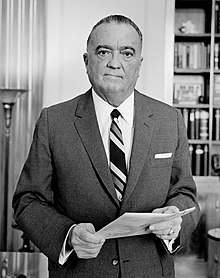
During the 1940s, Condon's security clearance status was repeatedly questioned, reviewed, and re-established.
On May 29, 1946, FBI Director J. Edgar Hoover wrote a letter intended for President Truman that named several senior government officials as part of a Soviet network. It described Condon as "nothing more or less than an espionage agent in disguise." (Decades later Senator Daniel Patrick Moynihan called it "baseless corridor talk.") The Truman administration ignored Hoover's charges.[23]
On March 21, 1947, Truman signed United States Executive Order 9835 AKA the "Loyalty Order."[24] In the same month, Congressman J. Parnell Thomas, head of the House Un-American Activities Committee (HUAC), furnished information to the Washington Times-Herald that denigrated his loyalty in two articles published.[25][26] Thomas had several reasons to make a prominent case of Condon. He had no sympathy for the scientific community's international spirit in the first place and could use the ongoing controversy to argue for an increase in his committee's appropriation, to bolster opposition to the Condon-supported McMahon Act, and to attract favorable coverage during election season.[27] The Department of Commerce cleared Condon of disloyalty charges on February 24, 1948.
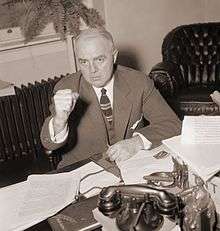
Nevertheless, a HUAC report dated March 2, 1948 stated, "It appears that Dr. Condon is one of the weakest links in our atomic security".[26][28] Condon responded: "If it is true that I am one of the weakest links in atomic security that is very gratifying and the country can feel absolutely safe for I am completely reliable, loyal, conscientious and devoted to the interests of my country, as my whole life and career clearly reveal".[29] On March 3, 1948, Senator Dennis Chávez (Dem-NM) read into the Congressional Record an article by Marquis Childs, which stated:
The current loyalty witch hunt is shown in its shabbiest and meanest form in the attack on Dr. Edward U. Condon... It relies almost on guilt by association. Because Dr. Condon, head of the National Bureau of Standards, talked to the wife of the Polish Ambassador and to two or three attachés of Soviet and satellite embassies, the committee demands his discharge. "It is known," said a letter quoted by the committee and purportedly from the FBI, "that in February 1947 Zlotowski (an attaché in the Polish Embassy) purchased 270 books on atomic energy which had been published by the Department of Commerce"... ”To fair-minded Americans it will seem clear that Condon is being persecuted because he was appointed head of the Bureau of Standards by Henry Wallace when Wallace was Secretary of Commerce."[30]
On March 5, 1948, Representative George MacKinnon (Rep-MN) stated: "Mr. Speaker, today's paper carries the story that the Secretary of Commerce, Mr. Harriman, has refused to respond to a congressional subpoena to supply information with respect to one Dr. Condon. I am not presuming to pass on the facts in that case, but I do wish to point out that this follows the same pattern of Secrecy as the administration has been following with respect to congressional subpoenas throughout this entire session."[28] On March 6, 1948, a Washington Post editorial stated, "There is an abundance of precedent for the Secretary's refusal to turn over his department's loyalty board files on Dr. Edward U. Condon." The Post also objected to an alternative proposal to send files on the Condon case to the top-level "Loyalty Review Board" in the Civil Service Commission. The Commerce Department's own loyalty board had already cleared Condon, and the Post argued that this decision should stand.[31] On March 8, 1948, Representative Chester E. Holifield (Dem-CA) noted: "...calling the attention of the Members to H. R. 4641, a bill which I introduced December 4, 1947. The purpose of this bill is to prescribe the procedures of investigating committees of the Congress and to protect the rights of parties under investigation by such committees. If this bill could be enacted, it would extend to a world-famous scientist, such as Dr. E. U. Condon, the same protection which is now available to a chicken thief or a traffic violator; that is, the right of defense against his accusers. Character assassination under the cloak of congressional immunity by a Member of Congress or a Congressional committee is a dangerous and abominable travesty."[28] On March 9, 1948, Representative Glen H. Taylor (Dem-ID), then Progressive Party vice presidential candidate, stated:
It is very difficult, Mr. President, to stand up against this diabolical Witchhunt. Witness the attack on Dr. Edward Condon the last few days. Here is a great American scientist, one of the greatest, who had already been cleared of suspicion; but in this witch hunt business, Mr. President, there is such a thing as double jeopardy. If one of these committees or the FBI gestapo make up their mind to get a man, they will come at him again and again from every angle until either they get him thrown out or the tension becomes so great that he gives up and bows out. We are going to wreck our atomic program with these methods, Mr. President, because scientists are self-respecting people Who refuse to be hounded and shadowed and have the finger of suspicion constantly pointed at them.[28]
On the same day, Representative Emanuel Celler (Dem-NY) stated:
"I believe the attitude and the action of the Un-American Activities Committee toward a very famous scientist, Ur. Edward U. Condon, has been very unjust and unfair. The conduct of that committee on the Condon case is typical. Dr. Condon has been deliberately made a victim of popular hysteria against Russia. He has not been heard by the Un-American Activities Committee. He requested a hearing twice before, and again last week; but his requests have been denied... The committee deliberately disregarded the views of the FBI. which said in effect that there was no evidence of disloyalty of Dr. Condon."[28]
On the same day, Representative Leo Isacson (ALP-NY) stated, "It is no coincidence that this attack on Dr. Condon—an attack abhorred and shamed in all responsible opinion of press and science comes at this particular moment—at this moment when the House Committee on Un-American Activities seeks the most swollen appropriation it has ever Ventured to ask of a Congress."[28] Holifield added, "The technique used by the committee counsel is biased and prejudiced... We have a flagrant example... in the partial report on Dr. Condon... I want to comment here on the use of the word “partial”... The committee counsel omitted a line of the [FBI] letter... 'There is no evidence to show that contacts between this individual and Dr. Condon were related to this individual's espionage activities'... This man, Dr. Condon, has been pilloried before the American people now for over 8 months. He has asked for a chance to tell his story; that chance has been denied"[28]
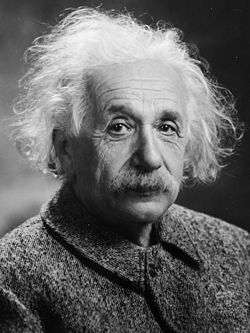
Defenders included Albert Einstein and Harold Urey. The entire physics department of Harvard and numerous professional organizations wrote Truman on Condon's behalf.[32] The Emergency Committee of Atomic Scientists held a dinner on April 12, 1948, to demonstrate support, with nine Nobel Prize winners among the sponsors.[33] The National Academy of Sciences, by contrast, considered only a statement criticizing HUAC's procedures rather than defending Condon. Despite widespread support among its members (275 to 35), the National Academy of Sciences' leadership did not release a statement, and instead opted to speak privately with Rep. Thomas.[34] On July 15, 1948, the Atomic Energy Commission granted Condon a security clearance, allowing him to access classified information at NIST.[35]
In September 1948, at the Annual Meeting of the American Association for the Advancement of Science (AAAS), President Truman, with Condon sitting nearby on the dais, denounced Rep. Thomas and HUAC on the grounds that vital scientific research "may be made impossible by the creation of an atmosphere in which no man feels safe against the public airing of unfounded rumors, gossip and vilification". He called HUAC's activities "the most un-American thing we have to contend with today. It is the climate of a totalitarian country".[4] Condon opposed any cooperation with Congressional attempts to identify security risks within the scientific community. In June 1949, in a sharply critical letter to Oppenheimer, who had provided information to HUAC about a colleague, he wrote: "I have lost a good deal of sleep trying to figure out how you could have talked this way about a man whom you have known for so long, and of whom you know so well what a good physicist and good citizen he is."[16] In July 1949, he testified before a Senate subcommittee that was considering rules governing the operation of Senate committees. He criticized Thomas and the HUAC for holding closed hearings and then leaking information that denigrated his loyalty and that of other scientists. He said that the committee denied his and his colleagues' requests for public hearings so they could respond.[36]
In 1949, Edward R. Murrow had colleague Don Hollenbeck contribute to the innovative media-review program, CBS Views the Press over the radio network's flagship station WCBS. Hollenbeck discussed Edward U. Condon, Alger Hiss, and Paul Robeson.[37] Regarding Condon, Hollenbeck critiqued anti-communists for going about their business the wrong way:
Communists want nothing more than to be lumped with freedom-loving non-Communists... This simply makes it easier for them to conceal their true nature, and to allege that the term 'Communist' is meaningless... At the same time, we cannot let abuses deter us from the legitimate exposing of real Communists.[37]
(Here, Hollenbeck was placing Condon in the "freedom-loving non-Communist" camp.)
1950s
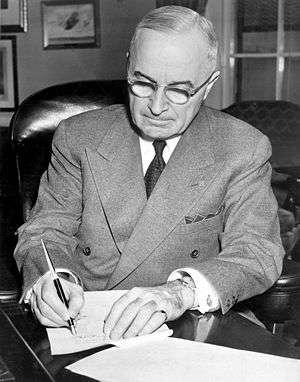
With his record finally cleared in 1951, Condon left government to become head of research and development for the Corning Glass Works. He said his $14,000 annual government salary was his reason for the move. President Truman issued a statement of praise: "You have served in a most critical position with continued and loyal attention to your duties as director, and by reason of your standing among scientists and the supervision you have given to the bureau's activities, you have made of it a more important agency than it has ever been before". Two Republican Congressmen asserted that Condon was being investigated as a security risk and was leaving "under fire", a charge the Secretary of Commerce Charles Sawyer denied.[38]
On December 27, 1951, Condon was elected to head the AAAS in 1953.[39][40][Note 3] In September 1952, Condon, in testimony before a Congressional committee, had his first opportunity to deny under oath all charges of disloyalty that had been made against him.[25] The HUAC concluded in its annual report for 1952 that Condon was unsuited for a security clearance because of his "propensity for associating with persons disloyal or of questionable loyalty and his contempt for necessary security regulations".[41] On December 30, 1952, Condon assumed the presidency of the AAAS at its annual meeting, where, according to the Bulletin of the Atomic Scientists, "The tremendous ovation by his fellow members accompanying his induction was a further affirmation of their faith in his loyalty and integrity".[40]
Five months later Condon's clearance was revoked as was standard when someone left government service.[25][40] He was granted a security clearance once more on July 12, 1954. It was announced on October 19 and then suspended by Secretary of the Navy Charles S. Thomas on October 21.[25] Vice President Nixon took credit for the suspension, and the Atomic Scientists of Chicago charged "political abuse of the national security system", though Secretary Thomas denied Nixon had played a role.[42][43] Condon withdrew his application for clearance and in December resigned from Corning because the company was seeking government research contracts and he lacked the clearance necessary for participating in military research. After citing the security reviews he had passed over the years, he said: "I am unwilling to continue a potentially indefinite series of reviews and re-reviews".[25] Corning had paid Condon's clearance-related legal expenses while he worked there.[44]
In 1958, Condon wrote that his decision reflected his belief that the Eisenhower administration "was committed by policy to the persecution of scientists, or, at the very least, to a callous indifference toward what others were doing to attack and discredit them. I decided the situation was hopeless, and that I had done all that could be reasonably expected of me in having resisted these forces for seven long years".[45]
Years later, Carl Sagan reported how Condon described one encounter with a loyalty review board. A board member stated his concern: "Dr. Condon, it says here that you have been at the forefront of a revolutionary movement in physics called...quantum mechanics. It strikes this hearing that if you could be at the forefront of one revolutionary movement...you could be at the forefront of another". Condon said he replied: "I believe in Archimedes' Principle, formulated in the third century B.C. I believe in Kepler's laws of planetary motion, discovered in the seventeenth century. I believe in Newton's laws...." and continued with a catalog of scientists from earlier centuries, including the Bernoulli, Fourier, Ampère, Boltzmann, and Maxwell.[46] He once said privately: "I join every organization that seems to have noble goals. I don't ask whether it contains Communists".[47]
Academia
Condon was professor of physics at Washington University in St. Louis from 1956 to 1963 and then at the University of Colorado Boulder from 1963, where he was also a fellow of the Joint Institute for Laboratory Astrophysics, until retiring in 1970.[4]
From 1966 to 1968, Condon directed Boulder's UFO Project, known as the Condon Committee. He was chosen for his eminence and his lack of any stated position on UFOs. He later wrote that he agreed to head the project "on the basis of appeals to duty to do a needed public service" on the part of the U.S. Air Force Office of Scientific Research.[48] Its final report concluded that unidentified flying objects had prosaic explanations. It has been cited as a key factor in the generally low levels of interest in UFOs among mainstream scientists and academics.[49]
Condon was also president of the American Institute of Physics[4] and the American Association of Physics Teachers in 1964.[12] He was president of the Society for Social Responsibility in Science (1968–69) and was co-chairman of the National Committee for a Sane Nuclear Policy (1970).[12] He co-edited the Handbook of Physics with Hugh Odishaw of the University of Arizona.[4] He received the Frederic Ives Medal awarded by the Optical Society in 1968.[50] On his retirement, his colleagues honored him with the publication of a Festschrift.[51]
Personal life and death
Condon married Emilie Honzik (1899-1974). They had two sons and a daughter.[52] The son, Joseph Henry Condon (15 February 1935 — 2 January 2012) was a physicist (Ph.D., Northwestern University) and engineer, who worked at Bell Labs on digital telephone switches and co-invented the Belle chess computer.[52]
Condon was a self-described "liberal."[21]
Condon died on March 26, 1974, twenty-four days after his 72nd birthday, in Boulder Colorado Community Hospital.[4]
Legacy
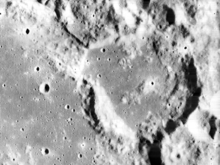
The National Institute of Standards and Technology (NIST) gives an annual award named for Condon. The Condon Award recognizes distinguished achievements in written exposition in science and technology at NIST. The award was initiated in 1974.[53]
Works
See also
Notes
- Some sources date The Theory of Atomic Spectra to 1936, but facsimile editions establish 1935 as the correct copyright date, along with Wheeler.[14]
- Condon was upset that Oppenheimer did not stand up to Groves, but he did not know that Oppenheimer had yet to receive his own security clearance.[16]
- The New York Times says he was to be president of the organization in 1954, but Wang, "Security" 265, establishes that the term was 1953.[39][40]
References
- Edward Condon Archived 2013-01-16 at WebCite was elected as a member of the US National Academy of Sciences in 1944.
- "APS Fellow Archive". www.aps.org. Archived from the original on 3 March 2016. Retrieved 22 April 2018.
- Branscomb, Lewis M. (June 1974). "Edward Uhler Condon". Physics Today. 27 (6): 68–70. Bibcode:1974PhT....27f..68B. doi:10.1063/1.3128661. Archived from the original on 2013-09-27.
- M'Ehle, Victor K. (1974-03-27). "Edward Condon, Leader In A-Bomb Creation, Dies". The New York Times. Archived from the original on 2012-11-06. Retrieved 2012-10-16. paywalled
- Morse, 125
- Morse, 126
- Morse, 127
- Condon, Edward Uhler (1927). On the theory of intensity distribution in band systems (Ph.D. thesis). University of California, Berkeley. OCLC 21068286. Archived from the original on 2019-05-14. Retrieved 2019-05-14 – via ProQuest.
- Morse, 128
- Wang, "Security," 242
- Wheeler, Geons, 112
- Branscomb, Lewis M. "Edward U. Condon, 1902-1974". Washington University Library. Archived from the original on 2013-01-05. Retrieved 2012-10-16.
- Wang, "Security," 241
- Condon, E. U. and Shortley, G. H. (1935). The Theory of Atomic Spectra. Cambridge University Press. ISBN 978-0521092098. Archived from the original on 2014-06-27. Retrieved 2016-03-31.CS1 maint: uses authors parameter (link)
- "1940: Nimatron". platinumpiotr.blogspot.com. Archived from the original on 25 December 2018. Retrieved 22 April 2018.
- Bird and Sherwin, 223-224
- Kelly, Cynthia C., ed. (2007). The Manhattan Project: The Birth of the Atomic Bomb in the Words of its Creators, Eyewitnesses, and Historians. Atomic Heritage Foundation. pp. 137–138.
- Wang, "Security," 243
- Wang, "Security," 243-4
- Wang, "Security," 244, 244n15
- Wang, Jessica (1 December 2001). "Edward Condon and the Cold War Politics of Loyalty". Physics Today. 54 (12): 35–41. Bibcode:2001PhT....54l..35W. doi:10.1063/1.1445546.
- "Edward U. Condon Papers". American Philosophical Society. 1998. Retrieved 20 October 2019.
- Moynihan, Secrecy, 63-8
- Harry S. Truman, Executive Orders Archived 2017-12-31 at the Wayback Machine The Federal Register, U.S. National Archives
- "Condon Abandons Clearance Fight". The New York Times. 1954-12-14. Archived from the original on 2018-07-22. Retrieved 2012-10-16.
- Wang, "Security," 246
- Wang, "Security," 252-5
- Congressional Record. US GPO. March 1948. pp. 1987 (Rankin report), 2018 (Chavez statement), 2222 (MacKinnon statement), 2337 (HR 4641 / Holifield), 2389 (Taylor), 2405 (Celler, Rankin), 2407 (Isacson), 2407–8 (Holifield). Retrieved 20 October 2019.
- Wang, "Security," 248-9
- Childs, Marquis (3 March 1948). "Washington Calling: Smear Against Condon". Washington Post. p. 2018. Retrieved 20 October 2019.
- "Loyalty Files". Washington Post. 6 March 1948. p. 8.
- Wang, "Security," 249
- Wang, "Security," 249-50
- Wang, "Security," 251
- Wang, "Security," 255
- Knowles, Clayton (1949-07-21). "Condon Hits 'Leaks' in House Inquiries". The New York Times. Archived from the original on 2018-07-22. Retrieved 2012-10-16.
-
Ghiglione, Loren (2008). CBS's Don Hollenbeck: An Honest Reporter in the Age of McCarthyism. Columbia University Press. pp. 146-147 (Condon), 147 (Counterattack), 148-149 (Hiss), 149-150 (Robeson). ISBN 9780231516891. Retrieved 10 September 2015.
Hiss Chambers.
- "Dr. Condon Resigns for Larger Salary". The New York Times. 1951-08-11. Archived from the original on 2012-11-06. Retrieved 2012-10-16.
- "Dr. Condon Chosen to Head Scientists". The New York Times. 1951-12-28. Archived from the original on 2017-03-16. Retrieved 2012-10-16.
- Wang, "Security," 265
- Wang, "Security," 264-5
- "Nixon Warns Foes of Reds in Party". The New York Times. 1954-10-23. Archived from the original on 2018-07-22. Retrieved 2012-10-16.
- "Nixon Remarks Cited on Condon Case Role". The New York Times. 1954-12-17. Archived from the original on 2018-07-22. Retrieved 2012-10-16.
- Bird and Sherwin, 460
- Wang, "Security," 266
- Sagan, Demon-Haunted, 248-9
- Wheeler, Geons, 113
- Dick, Biological, 293
- Sturrock, Peter A (1987). "An Analysis of the Condon Report on the Colorado UFO Project". Journal of Scientific Exploration. 1 (1): 75. Archived from the original on 2012-07-17.
- "Frederic Ives Medal / Quinn Prize". Optical Society. Archived from the original on 2014-02-01. Retrieved 2012-10-16.
- Brittin, Wesley E.; Odabasi, Halis, eds. (1971). Topics in Modern Physics: A Tribute to Edward U. Condon. London: Hilger.
- "Creator of Belle computer chess dies at 76". NJ.com. 2 March 2012. Archived from the original on 17 December 2014. Retrieved 17 November 2014.
- "Physics Lab: 2005-2007: Awards and Honors". NIST. Archived from the original on 2014-02-02. Retrieved 2012-10-16.
- "Condon". Gazetteer of Planetary Nomenclature. International Astronomical Union. Archived from the original on 2013-01-16. Retrieved 2012-10-16.
- "Halis Odabaşı's biography". Archived from the original on 2020-02-20. Retrieved 2020-02-20.
- Condon, E.U.; Odabaşı, Halis (1980). Atomic Structure. Cambridge University Press.
Works cited
- Bird, Kai and Sherwin, Martin J. (2005). "American Prometheus: The Triumph and Tragedy of J. Robert Oppenheimer". Physics Today. 58 (11): 51–52. Bibcode:2005PhT....58k..51B. doi:10.1063/1.2155759.CS1 maint: uses authors parameter (link)
- Clark, Jerome (1998). The UFO Book: Encyclopedia of the Extraterrestrial. Visible Ink. ISBN 978-1-57859-029-2.
- Dick, Steven J (1996). The Biological Universe: The Twentieth Century Extraterrestrial Life Debate and the Limits of Science. New York: Cambridge University Press.
- Morse, Philip M (1976). "Edward Uhler Condon: 1902 - 1974" (PDF). Reviews of Modern Physics. 47 (1): 1–6. Bibcode:1975RvMP...47....1M. doi:10.1103/RevModPhys.47.1.
- Moynihan, Daniel Patrick (1998). Secrecy: The American Experience. Yale University Press.
- Sagan, Carl (1996). The Demon-Haunted World: Science as a Candle in the Dark. New York: Ballantine Books. ISBN 978-0-345-40946-1.
- Wang, Jessica (June 1992). "Science, Security, and the Cold War: The Case of E. U. Condon". Isis. 83 (2): 238–269. doi:10.1086/356112.
- Wheeler, John Archibald (1998). Geons, Black Holes, and Quantum Foam: A Life in Physics. New York: W.W. Norton.
External links
| Wikiquote has quotations related to: Edward Condon |
- Edward U. Condon Papers @ American Philosophical Society
- Alsos Digital Library for Nuclear Resources: Annotated Bibliography for Edward Condon
- American Institute of Physics: Oral history interview transcript with Edward Uhler Condon 17 October 1967, 27 April 1968 & 11 September 1973, Niels Bohr Library & Archives
- Oregon State University: Key Participants: Edward Condon - Linus Pauling and the International Peace Movement: A Documentary History
- Bulletin of the Atomic Scientists Feb 1955, statements of Condon, Corning Glass, and the Atomic Scientists of Chicago, concerning Condon's resignation from Corning
- National Academy of Sciences Biographical Memoir
| Government offices | ||
|---|---|---|
| Preceded by Lyman James Briggs |
Director of the National Bureau of Standards 1945 – 1951 |
Succeeded by Allen V. Astin |